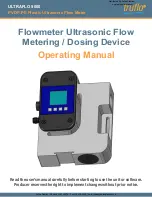
SDA Operator’s Manual
SDA-OM-E Rev H
191
Operational Notes
Once FastWavePort is selected, the right-hand dialog shows the current settings. The first of
these is critical, and indicates the base name of the memory window and the two events, which
are global within the Windows O/S. This should be left at its default value and only changed if
multiple FastWavePort functions are used in parallel. Note that this name must match the base
name used in the client application.
The full names of these global objects are:
Memory Mapped File
"FastWavePort1File"
Data Available Event
"FastWavePort1MutexDataAvailable"
Processing Complete Event
"FastWavePort1MutexProcessingComplete"
The "Timeout" field specifies the amount of time that the DSO will wait for the custom processing
function to complete. This prevents the DSO from waiting indefinitely for a potentially
unforthcoming custom processing function. Be careful to set this value to something reasonable,
which means a time that is longer by a reasonable margin than the custom processing is ever
expected to take.
Data Length Limitations
The size of the memory window is fixed at 80 Mbytes, which equates to 40 MSamples.
Performance
This is by far the fastest way to process data using a user-defined algorithm on an X-Stream
DSO.
Choice of Programming Language
The system was designed for use with the C/C++ programming language. However, it is
theoretically possible for the processing to be implemented in any language that supports
Windows named events (Mutex) and can open a named memory-mapped file. No guarantee can
be given, however, as to the behaviour of the system using anything but C/C++.
Example Application
This simple C++ application may be used as a starting point for a custom processing function. It
demonstrates the following:
•
How to create handles to the global objects (the memory window and the two events)
•
How to read data from the memory window when the DSO flags that it's available
•
How to scale the data into units of volts using data in the header that's stored at the
beginning of the memory window.
•
How to perform a simple processing function (in this case the absolute value)
•
How to define the physical units of the output of the processing function (in this case 'Amps')
•
How to flag to the DSO application that processing is complete
Содержание SDA
Страница 1: ...SERIAL DATA ANALYZER OPERATOR S MANUAL December 2007 ...
Страница 148: ...Standard Horizontal Parameter Help Markers Standard Vertical Parameter Help Markers 148 SDA OM E Rev H ...
Страница 223: ...SDA Operator s Manual Example 6 SDA OM E Rev H 223 ...
Страница 225: ...SDA Operator s Manual SDA OM E Rev H 225 ...
Страница 232: ...In this figure the panel has been pasted onto the Excel sheet for comparison 232 SDA OM E Rev H ...
Страница 243: ...SDA Operator s Manual This example used the CORREL Array1 Array2 function of Excel as depicted below SDA OM E Rev H 243 ...
Страница 246: ...246 SDA OM E Rev H ...
Страница 247: ...SDA Operator s Manual Excel Example 5 Using a Surface Plot SDA OM E Rev H 247 ...
Страница 279: ...SDA Operator s Manual Convolving two signals SDA OM E Rev H 279 ...
Страница 310: ...The jitter wizard is accessed from the Analysis drop down menu 310 SDA OM E Rev H ...
Страница 327: ...SDA Operator s Manual SDA OM E Rev H 327 ...
Страница 328: ...328 SDA OM E Rev H ...
Страница 394: ...394 SDA OM E Rev H ...
Страница 395: ...SDA Operator s Manual SDA OM E Rev H 395 ...
















































